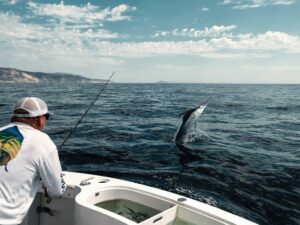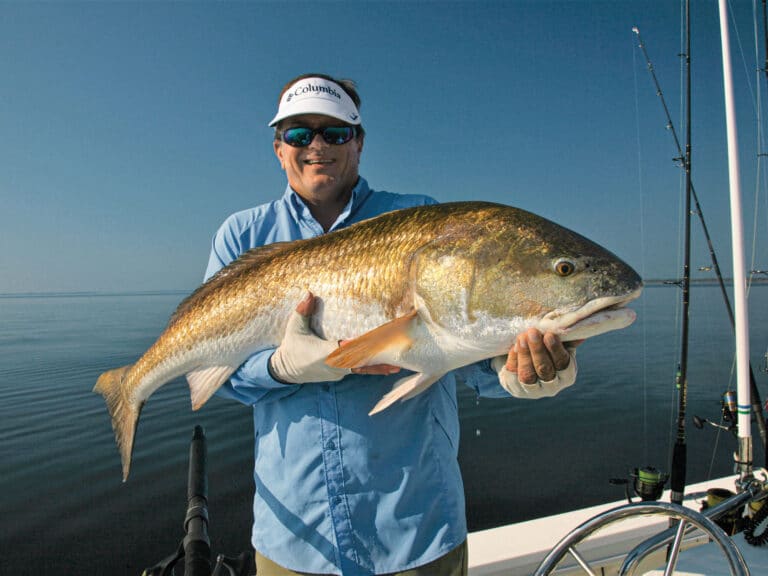
This is the forth in the series of articles written for the average bay fisherman who is interested in a professional fishing guides view on how, where and what bait he will select to get the day started. The next two articles are perfect for the approaching fall and winter fishing patterns. This article will cover bait and tactics for fishing the sand pockets in the flats that can be used on almost any day of the year however some of the specific bait and presentations in this article are more directed to the Fall and Winter patterns. Sand pockets are very important to isolating the effective water and intercepting the fish, almost any sand pocket can be lucrative on any given day. With that said I have limited out on Redfish many times within a few hundred yards of where I launched my boat, you just have to learn how to read the conditions and use that compiled knowledge to target those same areas of your previous success.
When I wake in the morning the first thing I do is fire-up the laptop and check the weather readings at several area locations and then I go on to review the forecast for the day. I pay particular attention to Temperature, Cloud Cover, Wind Direction, Wind Speed, in addition it is very important to note if the wind will be changing direction or speed during the day as that could mean the bite may slow down just before the switch and also alert you to change the way or direction you present the bait. Needless to say adapting to the weather is an extremely important asset for successful fishing. Also, when I’m getting to my boat I make sure the weather conditions seem as they did online, sometimes this is not the case. I have seen many a wrong forecast, more wrong forecasts than correct ones so you should learn to do your own forecasting too.
Now for selecting the bait or baits I will be using, if the wind is blowing 12kts or so I’ll surely select shrimp for drift fishing over the flats targeting the sand pockets or the edge of Oyster humps on my casts. You should be able to see the different shades even if it is very windy, the lighter shades are the sand pockets the darker shades are the Oyster humps or Grass areas. I like the smaller pot holes, however the bigger ones can produce too but when you fish the larger potholes or sand pockets try to cast for the edges or fingers if they have them and you should be able to cast to several edges before getting too close. If you have a power pole and hook up with a good fish in a pot hole or oyster hump, use your remote to deployed it as soon as the fish is taking drag, more often than not you will get extra fish off that area but don’t wait longer than 5 minutes without big fish action! You can use this sand pocket tactic when anchoring up using shrimp on a jig head (rip the head off and thread it on), a weighted line with a finger mullet or cut mullet to name the most often fished bait. Don’t forget there still may be croaker or piggies perch this late in the season too and they are still effective free lined in these pockets.
Remember on clam days you really have to cast far from the boat, even farther than that. I also GPS my favorite holes for those days that the sun doesn’t shine or it is too windy to see the sand pockets. On windy days and the fish are active avoid making ridiculously long casts, think about it, make casts the appropriate length from the boat to catch fish…you will cover more water! Now there are some days that are very windy/cold and you must cast very far from the boat because the fish may be a little slow, you will recognize these days by the amount of fish you or others are catching and the way the fish are taking the bait…adapt!
Let’s get down to the rigs I prefer when fishing these baits. I always use 20-pound fluorocarbon leader tied to the main line or cork. I use a Carolina Rig when fishing cut bait or live mullet with a 1/4- to 3 1/2-ounce weight. As with most live bait or lures I use a loop knot at the terminal or hook end.
- Leader — Easy, I use only 20-pound fluorocarbon! The leader length should be about 18″ give or take. It should be long enough to were the knot does not have to go through the eye when casting which prevents longer casts. When using a popping cork you want the bait to sit just above the height of the grass.
- Hooks — 3/0, 4/0, 5/0 6/0 Gamakatsu or VMC Kahle hooks depending on the size of the bait.
- Weights — 1/4 ounce to 3 1/2-ounce barrel weight.
- Corks — I predominantly use Cajun Thunders. On lighter wind days the old Mansfield Mauler could be an option too. I even save old corks for those days that the redfish don’t want a lot of sound!
- Cork Colors — I always start with two primary colors, pink and chartreuse. Most of the time you will find redfish like one and not the other and the same for trout, however they may be hitting both or you can select the color depending on when you are fishing an area more conducive to the fish you expect to catch.
- Knots — I use a line to leader knot instead of a swivel for the Jig Head leader however I tie a loop knot on the Jig Head. The only time I use a swivel is when fishing the bait on the bottom using a weight because at times I need a longer casts on the calm shallow flats and i want the bait to stay down. I tie a loop knot at the Kahle hook or end of the terminal tackle for more realistic movement.
- Accessories — Beads are not as important in this type of fishing but can be used, unless you are using the popping cork then use beads. If you’re going to try beads the general rule of thumb is to start with small beads and at least one rig without a bead. Really make sure your buddy’s is fishing the bait properly before ruling out any combination! Sometimes going to a larger bead when the water is very muddy or stirred up makes a difference!
Special Techniques
Here are some special tips to work these baits in the areas I mentioned, after time you’ll be adding your own special touches that work for you or your fish, whatever the case may be!
- When the bite is slow try using smaller pieces of cut bait.
- When fishing with Shrimp on a jig head make sure you squeeze the shrimp head off to leave the juices in place and don’t drop it in the water before the cast because you will loose some scent.
- When using shrimp on a jig head try to get larger bait even if you have to buy more than you want to get the right size, that is just the expense of fishing!
- Never use the huge Shrimp under a popping cork, the medium to small shrimp work a lot better! When you are on a hot bite you can us the shrimp a little bigger than medium.
- Remember to work the edges of grass or shell!
- Big shrimp can also be used on the Carolina Rig.
- Don’t hammer a small area, if the bite stops leave quietly and come back in a few hours, besides you won’t attract a crowd!
As always remember that nothing about fishing is set in stone. Pay attention, vary your approach and find what works! If fishing gets slow after a couple of good catches, I find that the angler gets a little pumped and doesn’t let the fish run enough!
I hope you’ve enjoyed this article, and remember: If you don’t eat it, release it. Try to release all big trout especially over 25 inches. Get a picture, it will last longer … And preserve some for our kids!
_— Capt. Scott McCune
**_”The Saltwater Cowboy”
**fishntexas.com
361-563-TUNA (8862)
Other Articles in this Series:
******Part 1: Bay Fishing with Bait 101**
Part 2: Popping Cork and Shrimp Texas Style
Part 3: Calm Summer Mornings to Windy Afternoons — Croaker & Piggy Perch









